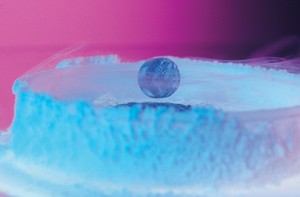Fifty years after the Nobel-prize winning explanation of how superconductors work, a research team from Los Alamos National Laboratory, the University of Edinburgh, and Cambridge University are suggesting another mechanism for the still-mysterious phenomenon.
In a review published today in Nature, researchers David Pines, Philippe Monthoux and Gilbert Lonzarich posit that superconductivity in certain materials can be achieved absent the interaction of electrons with vibrational motion of a material's structure.
The review, "Superconductivity without phonons," explores how materials, under certain conditions, can become superconductors in a non-traditional way. Superconductivity is a phenomenon by which materials conduct electricity without resistance, usually at extremely cold temperatures around minus 424 degrees Fahrenheit (minus 253 degrees Celsius)-the fantastically frigid point at which hydrogen becomes a liquid. Superconductivity was first discovered in 1911.

|
| ©Los Alamos
|
| This photo shows a magnet levitating above a high-temperature superconductor, cooled with liquid nitrogen. A persistent electric current flows on the surface of the superconductor, effectively forming an electromagnet that repels the magnet. The expulsion of an electric field from a superconductor is known as the "Meissner Effect."
|
A newer class of materials that become superconductors at temperatures closer to the temperature of liquid nitrogen-minus 321 degrees Fahrenheit (minus 196 degrees Celsius)-are known as "high-temperature superconductors."
A theory for conventional low-temperature superconductors that was based on an effective attractive interaction between electrons was developed in 1957 by John Bardeen, Leon Cooper and John Schrieffer. The explanation, often called the BCS Theory, earned the trio the Nobel Prize in Physics in 1972.
The net attraction between electrons, which formed the basis for the BCS theory, comes from their coupling to phonons, the quantized vibrations of the crystal lattice of a superconducting material; this coupling leads to the formation of a macroscopically occupied quantum state containing pairs of electrons-a state that can flow without encountering any resistance, that is, a superconducting state.
"Much like the vibrations in a water bed that eventually compel the occupants to move together in the center, phonons can compel electrons of opposite spin to attract one another, says Pines, who with Bardeen in 1954, showed that this attraction could win out over the apparently much stronger repulsion between electrons, paving the way for the BCS theory developed a few years later.
However, according to Pines, Monthoux and Lonzarich, electron attraction leading to superconductivity can occur without phonons in materials that are on the verge of exhibiting magnetic order-in which electrons align themselves in a regular pattern of alternating spins.
In their Review, Pines, Monthoux and Lonzarich examine the material characteristics that make possible a large effective attraction that originates in the coupling of a given electron to the internal magnetic fields produced by the other electrons in the material. The resulting magnetic electron pairing can give rise to superconductivity, sometimes at substantially higher temperatures than are found in the materials for which phonons provide the pairing glue.
Among the classes of materials that appear capable of superconductivity without phonons are the so-called heavy electron superconductors that have been studied extensively at Los Alamos since the early 1980's, certain organic materials, and the copper oxide materials that superconduct at up to twice the temperature at which nitrogen liquefies.
"If we ever find a material that superconducts at room temperature-the 'Holy Grail' of superconductivity-it will be within this class of materials," says Pines. "This research shows you the lamp post under which to look for new classes of superconducting materials."
Pines is the founder and Co-Director of the University of California's Institute for Complex Adaptive Matter, founded at Los Alamos in 1999, and a staff member of Los Alamos' Materials Physics and Applications Division. Monthoux is part of Edinburgh University's Centre for Science at Extreme Conditions. Lonzarich is at the Cavendish Laboratory of the University of Cambridge. The trio began work on the review when Pines was on leave from Los Alamos at Cambridge in 2000.
Reader Comments
to our Newsletter